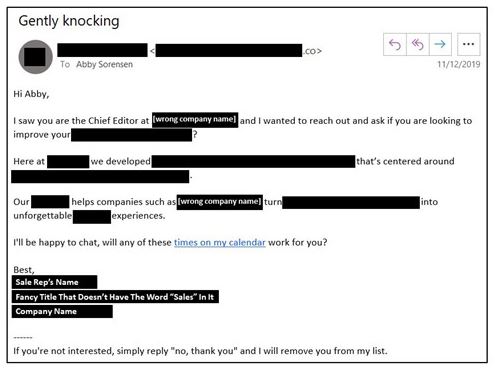The following is based on a true B2B content marketing story. The company and sales rep name has been hidden to protect the identity of what is likely a very frustrated marketing team.
Even though this example is not from a CDMO, it is a story told all too often to biopharma companies that are looking for the right outsourcing partner. Warning, this content may hit close to home if your sales follow-up isn’t focused on helping your biopharma buyers.
Once upon a time, a B2B marketing team invested some of their Series A cash to “do content marketing.” For over a year, these marketers worked tirelessly to produce content: More than 50 blog posts, plus training videos, and nearly a dozen customer case studies.
This team built a digital presence that is fresh, modern, and SEO-optimized with all the right keywords. The homepage wants the world to know that this company is all about “engagement,” “scalability,” and being “transformative,” all so that a buyer can get the “outcomes you’re looking for.”
Operations expanded globally. Fortune 500 logos were proudly plastered on the website. A badge of honor signifies inclusion on a top vendor list generated by a seemingly credible third-party trade association.
One year after this content marketing investment began, a hungry business development rep with an impressive Rolodex of relationships in the industry was brought on board to take sales to the "next level." Growth, another round of funding, an acquisition, an IPO – anything seemed possible.
So how can years of “doing content marketing” go so wrong? The answer to that question starts and ends with the wrong kind of sales follow-up.
Bad Sales Follow-Up Will Ruin Good Content Marketing
Even the best CDMO content marketing strategy is doomed to fail unless sales follow-up is existent, effective, and consistent.
So why do we keep sending boring, vague, sales-y emails with the hope that biopharma companies will engage? Don't we know better?
Below is a real-life series of emails sent over five weeks to a member of the Life Science Connect team (who, in this case, is the "buyer"). Take a look.
Email #1
Subject Line: “Gently Knocking”
What The Subject Line Should Be: “Praying This Reaches Your Inbox Because I Have A Quota To Hit”
That subject line won’t entice a buyer to open this email. And even if it did, nothing in this message speaks to the buyer; instead, it shouts useless information about the supplier.
Email #2
Subject Line: “Re: Gently Knocking”
What The Subject Line Should Be: “You Probably Won’t Read This Either, But Our Marketing Automation Vendor Recommends Sending This Now.”
Still no helpful content. Still not buyer-centric. Still no reason the buyer should consider this supplier.
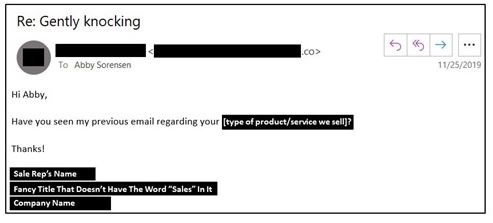
Email #3
Subject Line: “Re: Gently Knocking”
What The Subject Line Should Be: “I’m Really Interested In Selling You Something So Please Read This”
Not even cursory research has been done to show buyers why this supplier cares about their challenges. The company name will continue to be wrong because that’s what is loaded up in this marketing automation system – and because maintaining an accurate database is incredibly hard. All those content assets continue to be hidden away on the company website while this sales rep remains oblivious to the marketing materials at his/her disposal.
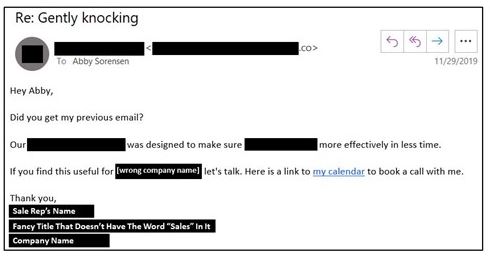
Email #4
Subject Line: “Re: Gently Knocking”
What The Subject Line Should Be: “There Are 5.4 People In A Buying Group But I’m Too Lazy To Find Out Who They Are So Can You Please Just Tell Me In Exchange For Nothing?”
Here, the buyer is expected to do all the work. Not only must the buyer scroll through a series of awful emails but there is no content to frame this request. Then the buyer is asked to reveal the name of a colleague so that someone else can be annoyed by this unhelpful series of emails.
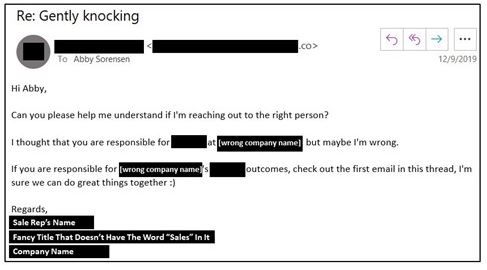
Email #5
Subject Line: “Re: Gently Knocking”
What The Subject Line Should Be: “Marketing Doesn’t Give Me Good Leads, But I’m Sending One More Useless Email Anyway So I Can Prove That I Did, In Fact, Follow Up.”
This is sent right before a sales rep demands more net-new leads because the current leads aren’t responding to any follow-up. And the buyer might have set off a false alarm by opening one of these five awful emails before deleting it. Or maybe the buyer’s email server triggered a robotic click in the process of passing it through the firewall. But no content has been read. No sales call has been scheduled. No contract will ever be signed.
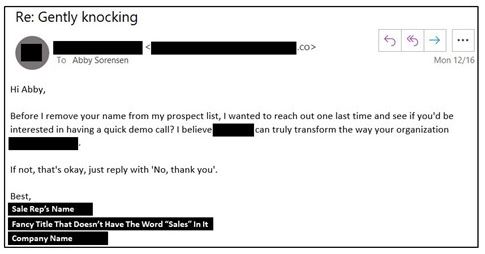
You may have fallen asleep reading these, just as any buyer would have. To recap, here are a few ways these messages ruin a content marketing investment:
- Nothing tailored to the buyer persona (even the company name is wrong)
- No helpful content is offered
- The message is 100 percent about the vendor and 0 percent about the buyer or the buyer's challenges
- An ask is made (schedule a demo) without giving anything (like helpful content) in return
Plus, the person on the receiving end of this email campaign does not have an active buyer’s journey (and isn’t a right-fit prospect in the first place). Regardless of how this contact entered the funnel, it could never and will never be a sales winnable lead.
Content Marketing Deserves Better
These B2B marketers invested years in creating content. They invested in identifying a prospect and capturing the email address, first name, and company name of that prospect. They invested in a marketing automation tool that would spit out these emails during a five-week campaign. They invested in analyzing open rates, demos scheduled, and conversions.
They are most definitely disappointed in the investment.
Although there are some assumptions made about this company’s story, the main details are true (as confirmed by their website, press releases, Crunchbase, and LinkedIn). It’s not a stretch of the imagination.
Too many CDMO sales and marketing teams follow nearly the same script, and there’s no excuse for it.
It’s easy to Monday-morning-quarterback examples like this – everyone is guilty of sending a less-than-perfect sales email at some point. CDMOs are wired to talk about their innovative approaches, regulatory expertise, and quality control. It’s hard work to follow along during the buyer’s journey instead of obnoxiously interrupting your buyer.
The intention here isn’t to criticize or mock a company/sales rep “doing content marketing” all wrong. The intention is to make CDMOs think long and hard about your sales follow-up and how you use content to help biopharma companies make outsourcing decisions.
CDMO marketers might assume their sales follow-up sounds nothing like this. But when is the last time you checked? Do you know what the sales team is sending to the leads you give them?
You can start doing that hard work of helping your buyer by taking a hypercritical look at the messaging and content you’re sending to them. You can do better than [Sales Rep’s Name], who is a [Fancy Title That Doesn’t Have The Word “Sales” In It], at this supplier with an ineffective content strategy.
Originally published on Follow Your Buyer
Let's work together.
Whether you're ready to hit the ground running or just starting and have questions, we're here to understand your goals and explore how we can help you.
